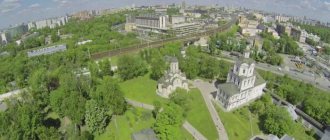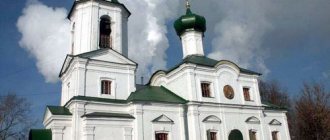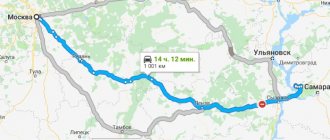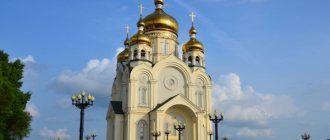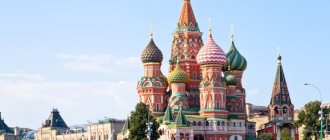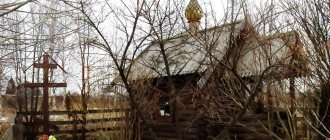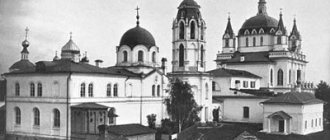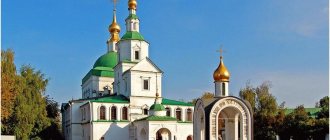| Spaso-Andronikov Monastery. Cathedral of the Savior Not Made by Hands, March 22, 2013 |
Spassky Cathedral
b. Andronikov Monastery, one of the oldest surviving white stone structures in Moscow
- Thrones: Savior Not Made by Hands (main), St. Andronik of Moscow (northern), Dormition of the Blessed Virgin Mary (south)
- Address: Russia, Moscow, Andronyevskaya square, 10, building 5. Metro station “Ilyicha Square”, “Rimskaya”
- Official site:
- On the map: Yandex.Map, Google map
It is no longer possible to establish the exact time of construction of the Spassky Cathedral; it is generally accepted that it was the 1420s.
There is only one written message that it was built. In the third Pachomiev edition of the Life of St. Sergius of Radonezh there is information that the cathedral in honor of the Image of the Savior Not Made by Hands was created under the disciple of St. Savva of Moscow - Abbot Alexander and icon painter Andrei Rublev, who painted the facades and interior of the cathedral, but only fragments have been preserved on two slopes of the windows in the altar of the cathedral – southern and northern. This painting is a stylized ornament placed in circles of equal size, connected to each other. Reconstructions of the cathedral began already in the middle of the century: a vestibule with two domes was added to it from the west. At the end of the 17th century, a new one with a hipped roof was erected on the site of the old bell tower.
During the fire of 1748, the Spassky Cathedral was heavily damaged by fire; During subsequent repairs, a new roof was made, which covered the original roof slab.
In 1763-1779 the cathedral was expanded. The narrow ancient doors were cleared and wide windows were installed.
At the end of the 18th century, the tented bell tower was dismantled.
During the French invasion in 1812, the Spassky Cathedral suffered again - the top completely collapsed. In the same year they began to restore it, in 1813 work continued, a new completion was made.
In the middle of the 19th century, the Spassky Cathedral was rebuilt once again. In 1848-1850, the architect P.A. Gerasimov installed an octagonal drum with a high tent and a dome. On the left (northern) side of the cathedral a chapel was built in the name of St. Andronik, on the right (south) side - in the name of the Dormition of the Blessed Virgin Mary. An iron-covered porch with porches was built. As a result, the cathedral acquired a look characteristic of the 19th century.
During the reconstruction of the Spassky Cathedral, the iconostasis also changed. In 1794, a four-tiered iconostasis with magnificent decoration was erected. The iconostasis of the early 19th century, made in the style of classicism, differed significantly from the previous one in greater restraint, monumentality of the composition, and emphasis on the central part. In 1867, it was replaced by a five-tiered wooden gilded iconostasis “with multi-figure carvings,” as evidenced by the “Main Inventory of the Spaso-Andronikov Monastery.”
In the Spassky Cathedral there was the greatest shrine of the monastery - a shrine with the relics of the first abbots of the monastery - the Monks Andronik and Savva.
Closing and destruction of the monastery
At the beginning of 1918, the Spaso-Andronikov Monastery was closed. Church utensils and icons were confiscated. Silver weighing more than seven pounds was torn from the reliquary in which the relics of the first abbots rested. What happened to the holy relics of Saints Andronicus and Savva is unknown.
In 1947, by order of I.V. Stalin, the territory of the monastery was transferred to the newly formed museum.
In the middle of the century, the restoration of the Spassky Cathedral began, as a result of which its ancient appearance was returned. The first restoration project for the cathedral was carried out by the famous architect Pyotr Nikolaevich Maksimov. P.D. also worked on the restoration project. Baranovsky, G.F. Senates; restoration work was carried out in 1959-1961 by a team of architects (B.L. Altshuller, S.S. Podyapolsky, M.D. Tsiperovich) under the leadership of L.A. David.
Revival of parish life
In the late 1980s, the director of the Central Museum of Ancient Russian Culture and Art named after Andrei Rublev (CMiAR), Sofya Vladimirovna Vashlaeva, turned to the abbot of the St. Danilov Monastery, Archimandrite Tikhon (Emelyanov), with a proposal for periodic services by monks in the Spassky Cathedral of the Andronikov Monastery. On July 17, 1989, on the day of memory of St. Andrei Rublev, with the participation of the brethren of the St. Danilov Monastery, a prayer service was held near the Spassky Cathedral.
For the Nativity of Christ in 1990, a temporary single-tier iconostasis with icons from the Danilov Monastery was prepared. On the eve of the holiday, the temple was consecrated by the minor rank of the dean of the St. Daniel Monastery, Archimandrite Luke (Pinaev).
Subsequently, services were performed on the twelve holidays. No work was carried out in the temple.
Since Christmas 1991, services began in the church on Sundays.
The parish's publishing activities began in 1992 with the publication of the first collection of articles on church art, “The Banner,” as well as sheet music—transcriptions from hook manuscripts of ancient chants.
In 1993, after receiving additional premises, an icon-painting workshop was organized.
In 1993, the western facade above the entrance to the cathedral was decorated with wall paintings - the image of the Savior Not Made by Hands. There was a similar one here in ancient times, it belonged to the brush of Andrei Rublev. The modern image is made using the thermophosphate painting technique, which is resistant to various environmental influences. The methodology of the new painting technique was developed by O.B. Pavlov. Proris “The Savior Not Made by Hands” was performed by N.V. Gusev, and paintings by O.B. Pavlov and A. Remnev.
In the same 1993, they decided to find the site of the ancient throne of the Spassky Cathedral. We turned to the director of the Central Medical Research Center S.V. Vashlaeva and received permission to conduct survey work. During these works, the relics of six monks from the early 15th century were discovered under the altar of the cathedral. In this regard, the cathedral was visited on January 4, 1994 by Patriarch Alexy II, who approved the work carried out and blessed the parish for further research.
During the restoration work, twelve white stone carved blocks were discovered. It has been established that ornamental carvings were made in the immediate vicinity of the limestone deposit, immediately after its extraction. This is how experts explain the features of most surviving reliefs: the stone decor looks as if it was made of a soft plastic material, the thinnest edges of the carving on it are not chipped. Perhaps, at the end of the 14th – beginning of the 15th century, the altar barrier of the Spassky Cathedral of the Andronikov Monastery was a carved white stone wall, which included preserved blocks with reliefs.
In 1995, the building of the ancient monastery chapel “Proscha” on Tulinskaya Street was transferred to the parish (at the request of the parish, this street is now named after Sergius of Radonezh). The chapel was restored by 2000. It serves prayer services and memorial services, and houses a church shop.
In 1998, the parish received rights to a plot of land next to the monastery, where the ancient monastery cemetery was previously located. And in 2000, construction began on this site of a temple in the name of the Holy Blessed Grand Duke Dimitri Donskoy, which was consecrated on December 20, 2015.
In 2015, land was acquired near an ancient well destroyed in the 1920s, dug by the holy abbot Andronik on the banks of the Yauza River, 200 meters from the monastery, for the restoration of the Holy Well and the construction of a chapel. Now there is a worship cross installed there.
Simultaneously with the organization of the parish, a library of spiritual literature began to be formed. Currently it contains about 2000 books.
Where is the Spassky Cathedral of the Andronikov Monastery
The Andronikov Monastery of the Savior Not Made by Hands was founded, according to studies of the biographies of holy people, by Metropolitan Alexy as a metropolitan residence. The Metropolitan assigned Andronik, a disciple of the wonderworker Sergius of Radonezh, to be involved in the organization of the monastery. The Abode of the All-Merciful Savior historically inherited his name.
The original wooden cathedral and monastery walls were supposedly built between 1357 and 1361. The buildings were erected on the Grand Duke's land 7 versts east of the Kremlin walls, near the mouth of the Yauza. Nowadays, the architectural ensemble of the monastery is geographically included in the Central Administrative District of the capital's metropolis.
The monastery complex is listed as building No. 10 on Andronevskaya Square. Within the walls of the historical building there is a Museum named after the famous icon painter Andrei Rublev, the collection of which contains priceless objects of ancient Russian painting. Divine services are held in the existing Cathedral of the Image of the Savior Not Made by Hands.
However, let us return to the moment of the founding of the temple.
The monastery and temple appeared in 1360. The favorite student of Sergius of Radonezh, monk Andronik, was chosen as its first abbot. Initially, all buildings, including the temple, were wooden. But in 1368 a fire broke out on the territory of the monastery, destroying the temple. It took almost 60 years to restore it. And only in the 20s of the next century the temple was built in the form in which it appears before us today. True, not everything has been preserved since then, of course. For example, it is known that Andrei Rublev and Daniil Cherny were also involved in painting the temple, but nothing has survived from their drawings to this day, with the exception of small fragments of ornaments on the slopes of the altar windows.
How to get there
It is convenient for travelers and pilgrims to start their journey to the monastery complex from the Moscow metro station “Ilyich Square”. From the railway platform to the monastery gates there are 890 m, which can be overcome in 10 minutes.
Route: turn left from the station, walk along Sergius of Radonezh Street to Andronevskaya Square, turn right on the square, walk along the path of the square past the monument to Rublev to the entrance of the monastery. You can make your journey easier and take one stop to the square on the 55th, 125th, 40th bus or 45th trolleybus.
Alternative route options start from the “Rimskaya” and “Marksistskaya” metro stations.
| Metro station | Distance | How to get there | Travel time |
| Ilyich Square | 890 m | On foot | 10 min |
| Roman | 1 km | On foot | 12 min |
| Marxist | 1.4 km | Bus 567 Stop – “Andronevskaya Square” | 3 stops – 5 min., then 330 m on foot – 4 min. The entire journey will take 9 minutes. |
Story
The Spassky Cathedral in wood was built upon the return of Metropolitan Alexei from a trip to Constantinople. The Metropolitan's ship was caught in a storm. Amid the confusion and panic, the priest maintained his fortitude, prayed earnestly and made a vow to the Savior to build a temple. He promised to dedicate the future prayer building to that holy holiday, on the day of which the travelers would safely reach the shore.
The Metropolitan did not break his word: he erected the Cathedral of the Image of the Savior Not Made by Hands in honor of the Feast of the Arrival. In the altar they placed the icon he had brought from his journey, showing the face of the Savior not made by hands on a board.
History has not preserved the exact date of construction of the stone cathedral.
Researchers of ancient architecture define the chronological framework of the building as the 20s of the 15th century.
Several editions of “The Tale of the Massacre of Mamayev” mention the construction of the Spassky Memorial Church in memory of the soldiers of the Battle of Kulikovo, buried on the territory of the monastery. The Spassky Cathedral of the Andronikov Monastery, according to other church sources, was erected in white stone under the third abbot of the monastery, the Monk Alexander.
Spassky Cathedral of the Andronikov Monastery before restoration
The cathedral walls were painted by famous painters, novices of the monastery, Andrei Rublev and Daniil Cherny. For their zealous desire for fasting and prayer, the Creator rewarded them with an unprecedented talent for sensually depicting the divine light with simple, material colors.
The cathedral was rebuilt more than once. The first renovation took place already in the middle of the 15th century: a vestibule topped with two domes was added to the western part of the temple. Over time, this structural element was removed.
At the end of the 17th century, a tented bell tower was added; at the end of the 18th century, it was dismantled. The cathedral was re-covered, the windows and doors were expanded. At the beginning of 1813, the temple, damaged by fire during the Napoleonic invasion, was repaired with a new domed top.
An amazing fact: in the building that was engulfed in fire, everything burned down except the reliquary with the relics of the first abbots of the monastery, who were canonized.
The holy building underwent a serious transformation in the late 40s of the 19th century. The construction of the temple according to the architectural design of P.A. Gerasimov was modernized by installing an octagonal hipped dome with an onion dome.
The tent covered the decorative cascade of the upper part of the temple, and deprived it of architectural originality. Two chapels were added to the main volume on the southern and northern sides, and a porch was installed under an iron roof with a decorative entrance.
The cathedral freed itself from the fashion trends of the 19th century in the mid-20th century. The reconstruction returned the building to its ancient, original appearance. The Museum of Ancient Russian Painting was opened on the territory of the monastery, and since 1989, divine services have resumed within the walls of the ancient prayer building.
As the chronicles report, the future Metropolitan Alexei (not yet ordained) swam across the Black Sea
To be ordained to this dignity by the Ecumenical Orthodox Patriarch in Constantinople (Constantinople). In those days, such a trip was mandatory. Because before the capture of Byzantium by the Turks, the Russian Orthodox Church was subordinated to the Byzantine one. And when the metropolitan, already confirmed in his rank, went home, the ship was caught in a severe storm. Multi-meter waves tossed the boat like a piece of wood, and then Alexei began frantically praying to the Miraculous Image of the Savior, but the waves did not decrease. and the Metropolitan swore to the Lord to build a monastery and temple in the vicinity of Moscow in honor of this image of Christ. Soon the storm calmed down and miraculously it turned out that Metropolitan Alexei and his charges returned to their homeland just on the bright day of the Feast of the Savior Not Made by Hands.
Architectural features of the temple
The ancient Cathedral of the Savior Not Made by Hands is a cross-domed church with one dome and 4 internal supports, an example of early Moscow architecture. The compositional peculiarity of the cathedral is expressed in the dynamic tension of the silhouette, the solemn aspiration of the entire structure upward.
The Spassky Cathedral of the Andronikov Monastery is made of rectangular limestone blocks with a polished front surface. White stone for construction was mined near the monastery, and the Kremlin buildings were built from the same limestone.
The main volume in the form of a small cube is installed on a high basement. In the upper part, the structure is decorated with a decorative cascade: one row of kokomars in the form of a semicircle with a point above the middle of the arc and two rows of kokoshniks. The light drum ends in a hemispherical dome topped with a cross.
On three sides, the temple structure is complemented by covered extensions with promising entrance portals. The ends of the portals and narrow windows have a lancet shape. White stone stairs leading to the portals emphasize the slender silhouette of the prayer building.
In the eastern part, three altar semicircular apses, covered with semi-domes, adjoin the base of the temple. The facades are divided by projecting pillars (pilasters), which coincide with the internal projections and interior arches.
Above the western entrance portal there is a round medallion with the image of the Savior Not Made by Hands. The picturesque painting was made during restoration using innovative phosphate paints that are resistant to the adverse influence of climatic conditions. The drawing reproduces the lost fresco “The Savior Not Made by Hands,” painted in the 15th century by Andrei Rublev.
The Spassky Cathedral, with its architectural individuality and perfection of lines, became an inspired model for architects of the 15th and 16th centuries. Craftsmen from all Russian lands visited the Andronikov Monastery to see the majestic temple, and then reproduce its architectural features in new church buildings.
A famous copy of the Spassky Cathedral is the Cathedral of the Nativity of the Virgin Mary (1505), located in the Nativity of the Virgin Mary Monastery in Moscow.
For example, raised arches supporting vaults, forms of half arches and zakomara.
If we talk about the artistic image of this temple as a whole, then its authors managed to fill their creation with extraordinary dynamics and tension. It’s as if they deliberately lowered the corner parts, and raised the middle divisions to the main volume. The composition creates a feeling of striving upward, forward, into the future. The cross-domed form of building the temple, traditional for its time, was boldly changed by them, as if preparing the ground for new daring and bold searches of Russian architects of the following centuries.
.And in our time, when passing through the gates into the territory of the monastery, you catch yourself with the amazing feeling that you have been transported from the noisy and hectic life of Moscow somewhere very far away, into a completely different world, leisurely and quiet, within which time flows in its own special way laws
Interior decoration
4 main pillars divide the interior of the cathedral into 3 elongated rooms (nave). A cylindrical vault, supported by pillars, forms a cross under the dome at the intersection of the axial lines. The walls of the temple are decorated with vertical flat and narrow projections, which visually increase the height of the prayer room.
There are no princely choirs in the temple, concealing the space. 8 windows of the drum, window openings of the main volume and light slits of the central skylights create three registers of daylight sources, which promotes uniformity of lighting and brings a sense of transparency and rational organization to the interior.
The temple murals by famous painters Andrei Rublev and Daniil Cherny were almost completely cleaned off in the 18th century, and the cathedral was no longer decorated with frescoes. Small fragments of painted canvases by legendary painters have been preserved. Framed by the window of the church altar, one can see a floral ornament on a rich blue background, enclosed in interconnected circles of the same size.
In the 90s of the 20th century, during the restoration of the building, a heating and lighting system was designed, the interior of the temple was transformed: the elevation of the altar and the throne were redesigned. During the repair work, about a dozen white stone blocks decorated with carved decor were discovered.
There is an assumption that the altar barrier was made from relief, decorative stones in the original temple. Now samples of ancient stone decoration serve as exhibits of the monastery museum of ancient art.
The cathedral iconostasis underwent changes throughout the entire period of the temple's existence. At the end of the 18th century, icons were arranged in 4 tiers, the design had a lush, expensive decor.
Iconostasis before restoration
At the beginning of the next century, the altar partition in the classical style was distinguished by its exquisite severity and compositional dominance of the central fragment. In the mid-19th century, it was replaced by a luxurious gilded iconostasis with figured carved decor.
The modern wooden iconostasis is endowed with conciseness and simplicity. The walls of the cathedral are decorated with icons of a new type. There are not many of them. On one of the walls there is a unique image of the third abbot of the monastery, St. Alexander, under whom the stone Spassky Church was built. You will not see an icon with his image anywhere else.
Temple shrines
The main shrine of the temple is the Image of the Savior Not Made by Hands. The revered 14th century icon was long considered a lost relic. In the last year of the 20th century, it was discovered in the storerooms of the Novodevichy Convent. In the iconostasis of the Cathedral of the All-Merciful Savior there is a copy of the holy image.
The temple shrine - the icon “Reverend Andronicus and Savva”, painted in the 19th century, has recently been rediscovered. An icon depicting the first abbots was discovered in the storage of the Church of the Resurrection on Arbat, and returned to the temple.
For many centuries, the cathedral housed a sacredly preserved relic - an ark with the relics of the first abbots of the holy monastery. During the revolutionary years, the heavy silver decoration of the ark was stolen , and the remains of the holy monks disappeared. However, there is hope that it is not without a trace.
During restoration and survey work, an ancient throne structure and 4 burials, located in pairs, were found under the cathedral altar. The appearing and disappearing fragrance when the burial was opened indicated that the discovered remains were the relics of holy people.
The monastic robes found date back to the beginning of the 15th century. An unconfirmed assumption is that the relics of the first four abbots of the monastery were discovered in the burial.
Further research into the fundamental basis of the altar yielded a new discovery. The burial of two monks was discovered. Scientists suggest that the remains of the famous icon painters Elders Daniel and Andrew have been found. The recovered relics of the six holy ascetics were transferred to newly created arks and displayed in the altar of the temple for worship.
The decoration of the temple has changed several times over the past centuries.
For example, according to an inventory made in the 1760s, there was a porch with a beautiful sacristy chamber, but nothing remains of it. The temple suffered great losses and in 1812, the retreating soldiers of Napoleon plundered the cathedral and burned the iconostasis. In 1934, this ancient monastery was going to be demolished, but, fortunately, this did not happen. At the end of the 50s of the last century, a very thorough and thorough reconstruction took place here.
Daily life of the temple
In addition to divine services, the clergy and the parish of the church are doing a lot of work to restore church values and spiritual traditions. The Orthodox community participated in the arrangement of a monastery in the Rostov region and the establishment of a monastery in the Rostov Epiphany monastery.
Parishioners helped in the search for the original location of the throne of the ancient Church of the Savior, as a result of which burials were discovered and shrines were discovered. The parish received approval and blessing from the highest clergy for subsequent survey work.
An icon painting workshop is organized at the cathedral - one of the best in the country. Talented painters in their works follow church canons, traditions and techniques of ancient Russian temple painting, and restore bit by bit the knowledge forgotten in Soviet times.
The most famous tradition of the monastery of the All-Merciful Savior - the Znamenny chant - has been renewed. A school of ancient Russian singing was organized at the cathedral, ancient music manuscripts were deciphered and published.
Pilgrimage plays a big role. Travel is organized to places sacred to the Orthodox faith for the purpose of prayer and worship. The church parish is working to republish ancient books, publish periodical Christian literature, and form a monastery library. The official website has been opened.
Current state[edit]
Iconostasis
Now at the church there is a Sunday school for children and a youth group, conversations are held with adults, icon painting courses are open to everyone, various master classes and other events are held.
For example, there are master classes on decorative techniques and crafts. Classes are taught by professional florist designer O.M. Kashevich. At Sunday school, she teaches children decoupage, wool felting and other decorative techniques on fabric, paper, porcelain and wood. Master classes in the Spassky Church are held with the blessing of the rector of the church, Archpriest Nikolai Simonov, as part of missionary work and are designed to strengthen the community and help people become better acquainted with the extra-liturgical life of the parish and with each other. All master classes are free and are held on Saturdays and Sundays as required.
Opening hours and schedule of services
The Spassky Cathedral of the Andronikov Monastery is open from 11 a.m. to 6 p.m. daily. At 14:00 the temple closes for 45 minutes. The church holds holiday and Sunday services. The service time is specifically indicated in the schedule on the official website of the monastery.
The priests of the Spassky Cathedral conduct weekday services in the Proshcha chapel, located next to the monastery, on Sergius of Radonezh Street, in building 25. The chapel is open to parishioners and pilgrims from 8 a.m. to 7 p.m. Regular services are held at 8:00, 9:00, 17:30.
In 1354, Metropolitan Alexy began construction of the Savior-Andronicus Monastery
The storm has subsided. The ship safely landed on the Russian coast and already in Moscow, the Metropolitan turned to St. Sergius of Radonezh with a request to give him his disciple Andronik to create a monastery with the Church of the Savior Not Made by Hands.
These events took place in 1354. The Monk Andronik became the abbot of the monastery, and in 1360 the wooden Spasskaya Church was built.
The miraculous image of the Savior. Metropolitan Alexy prayed for salvation during the storm in front of this icon and gave his word that upon returning to his homeland, he would build a temple in Moscow
Over the years, the wooden walls of the church became dilapidated, and in 1420, under Metropolitan Photius, a decision was made to build a stone church.
Thus, at the end of the 1420s, the Spassky Cathedral, unique in its architecture, was erected.
In 1425, Andrei Rublev and his icon-painting team went to Moscow to paint the new Christmas tree church of the Spaso-Andronikov Monastery.
St. Andrey Rublev. It was he who painted the new white stone church of the Spaso-Andronikov Monastery
This was the last work of the great master. In 1430, the icon painter died and was buried within the walls of the Andronikos Monastery.
Interesting facts about the Spassky Cathedral of the Andronikov Monastery
The Spassky Cathedral of the Andronikov Monastery is inextricably linked with the history of the country; many outstanding people have visited its walls. The temple and monastery were erected on a landmark territory - the meeting place of Russian regiments led by Grand Duke Vsevolod Yuryevich with the enemy army of the Mongol Khan Batu.
There is information that within the walls of the first wooden church, Grand Duke Dmitry Donskoy, before the battle on the Kulikovo Field (1380), prayed to the Savior for victory, and here he offered a grateful prayer to the Creator.
Fragments of carved white stone blocks found during the restoration of the Spassky Cathedral. Late XIV – early XV centuries.
In the mid-17th century, Archpriest Avvakum Petrov was kept in the monastery for three months, imprisoned for preaching the Old Believers and rejecting Nikon’s church reform.
Queen Evdokia Lopukhina, wife of Peter the Great, prayed here. Through the efforts of the last Russian queen, equal in birth to her husband, the Church of the Archangel Michael was erected above the refectory. In the lower tier there was a tomb for parents, close relatives of the royal person, and noble Moscow nobles.
Sergei Vasilyevich Rachmaninov came to the church for services to listen to the amazing znamenny singing of the church choir. Nowadays, the Andrei Rublev Museum of Ancient Russian Art operates within the walls of the monastery. Perhaps this is the best monument to the outstanding holy ascetic, the legendary Russian painter. All the icons he painted had miraculous powers.
The Andronikov Monastery with its marvelous Spassky Cathedral is a dear guest from past centuries, bringing divine light, age-old wisdom and the delightful aesthetics of ancient Russian art to our modern world.
Article design: Vladimir the Great
Outdoor architecture
The cathedral was built in honor of the icon of the Savior Not Made by Hands. The entire appearance of the temple confirms how carefully Russian architects in ancient times approached the creation of this church building.
The appearance of the temple is church-domed, this can be noticed immediately when viewing it from the front side. The monastery has one dome and four internal supports.
The entire structure of the monastery is directed upward, which is characteristic of the era of Vasily I. People want to be closer to God, and the church is their main guide to the Heavenly powers.
The silhouette of the temple is tense and expectant. This is also connected with the time when the cathedral was erected. All of Rus' was waiting for deliverance from the invaders from the East.
The material of the walls of the monastery resembles that from which the Kremlin was built. These are limestone blocks, polished only from the front surface.
What do you need for a wedding in a church?
Why do couples cement their union in the church? How to prepare yourself for the sacrament of wedding? Which day should I choose? Is it possible to get debunked?
The upper part of the monastery, where the dome is located, is hollow inside, acting as a small non-residential room. It is needed to hold the cross and the dome, made in the form of small squares.
The style of narrow windows in the portals completes the exterior decoration. It is typical for Ancient Rus' so that a small amount of light penetrates inside.
